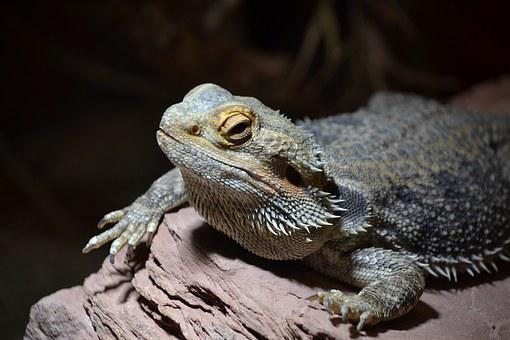To keep your bearded dragon’s tank clean and fresh, make sure to do light cleaning every day (morning or evening) and deep cleaning once a week. Light cleaning would include changing the water in a bowl if you have one, removing any remaining bugs, spot cleaning for poop, and washing the water bowl with hot water and soap.
Deep cleaning would be removing the substrate and cleaning it, cleaning the inside of the tank, and washing and disinfecting the accessories and glass. Use can use Windex to clean the glass tank from the outside but not from the inside because the glass tank needs to get sanitized and that is done with the other things.
Start by using an algae pad to thoroughly wipe the interior of the glass. Algae scrapers come in a wide range of styles, from long-handled scrubbers to magnetic scrubbers. Instead of the housewares section of a conventional store, get algae pads at a pet store. The houseware pads may have chemical or soap residue even though they may appear identical. Even if you are washing your kitchen sink, that residue could be fatal to your fish. 1
Use a razor blade to scrape any tough residue from the glass. Don’t cut yourself, please. Use a plastic razor blade if your aquarium is made of acrylic because regular razors will scratch it.

What can I clean my bearded dragon’s tank with?
You must remove your bearded dragon from its tank, put it in a large container, and relocate it to a different room to thoroughly clean the tank. To prevent your dragon from breathing in any potentially harmful vapors, do this.
After that, remove all the extras and place them in a distinct bucket. Keeping a separate bucket just for cleaning your bearded dragon is a wonderful idea. Since the majority of tank accessories are made of porous materials, you should clean them at least once a week. They will begin to smell if you wait a long time to clean them, and you won’t be able to clean them later.
To clean, remove the substrate. Use paper towels, tiles, or a reptile carpet similar to this one in the tank where your dragon is kept. Avoid using any loose substrate because it could be harmful and result in impaction. The terrarium glass must next be cleaned, followed by the accessories.
Is Windex safe for terrarium?
NO. Coaltars, which are used in its production, is exceedingly hazardous to cold-blooded creatures. Instead, use vinegar or bleach! I don’t even use it to clean my windows because the mist could kill them if it gets to them in the other room, so it isn’t worth the risk.
Is it Dangerous to Have a Venomous Pet Like a Bearded Dragon?
Bearded dragons and their venomous nature can pose potential dangers when kept as pets. While bearded dragons do possess venomous glands in their mouths, their venom is generally considered harmless to humans. Nonetheless, caution should be exercised while handling them, as a bite or scratch can still cause infection. It is advisable to research and understand the proper care and handling techniques to ensure a safe environment for both the pet and its owner.
Do Crocodiles Lay Eggs or Give Birth?
Crocodile reproduction methods differ from those of mammals. Unlike giving birth, crocodiles lay eggs. These reptiles build nests to protect their eggs, which are then incubated by the heat of the sun or rotting vegetation. This fascinating aspect of crocodile biology showcases their remarkable ability to adapt to their environment.
What can I use to clean my reptile tank glass?
There are steps involved that how you can clean your reptile tank from inside and outside.
- If your dragon’s reptile carpet isn’t too dirty, you may just use a vinegar solution to spot clean it every few days. Mix 50 percent vinegar and 50 percent water to create a vinegar solution. Pour it into a sprayer and use it to apply it to the necessary cleaning areas. Following that, you can wipe it with a sponge or piece of paper. After breathing, go back to the cage.
- You can soak wash the carpet with soap and hang it to dry if there is any excrement on it. Having a spare carpet on hand to use when cleaning another one is always a smart idea. Additionally, soak the carpet in a bleach solution once a month to properly clean it (1 part bleach to 10 parts water). You can also think about replacing it entirely every two to three months.
- Take out all the tank accessories, including branches, hammocks, ramps, and other items, for a thorough weekly cleaning.
- The accessories can be scrubbed with a brush or a toothbrush and washed in hot, soapy water. Bearded dragon faces can be removed from wood by washing the branch with soapy water, baking it, or using hot pressurized steam to clean it. All the parasites can be killed with heat by baking at 250–300 degrees for 25–30 minutes. Wooden items can be thoroughly cleaned with boiling as well.
- You must also clean and sanitize the interior of the tank once a week. Start cleaning the glass after taking away all the decor and bedding.
- There aren’t many options for cleaning the inside of the tank. A non-toxic chlorhexidine solution is the first option because it has antibacterial, antifungal, and antiviral properties.
- This type of chlorhexidine solution is available and must be combined with water for cleaning. Utilizing a steam cleaner, which can eliminate any parasites with hot, pressurized steam, is an additional alternative for cleaning the interior of the tank. Also non-toxic because you’ll simply be using water.






